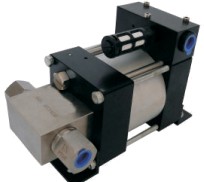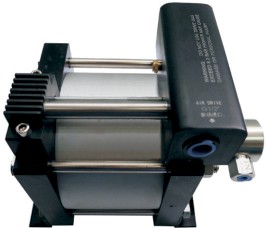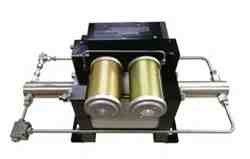
High Pressure Air Driven Liquid Pumps
Gretec Pumps has more than 50 years of hydraulic and pneumatic engineering experience in the design and manufacture of pumps and systems for pressure testing and chemical injection.

Gretec Air Driven Liquid Pump Design
Our range of liquid pumps are pneumatically driven, reciprocating plunger pumps. The pumps are ratio devices that utilize low pressure compressed air to drive a larger diameter piston (area x pressure), which is linearly connected to a smaller hydraulic piston/plunger. Using this ratio principal, a higher hydraulic pressure can be generated. Materials of construction include an all stainless steel wetted end and polyurethane pressure seals as standard. Specialized construction materials and special seals are also available on request. The liquid pumps are compact and lightweight, require no airline lubrication and are suitable for use in water, oil and most chemical applications.

Choosing from the right Air Driven Liquid Pump series
Gretec liquid pump model numbers reflect the pump’s nominal pressure ratio, that is, how many times greater pressure can be generated from the air drive pressure. You need to use these ratios, along with your specific output pressure requirements to select your pump. In addition, we categorize pumps into different series based on the size of the air drive and the stroke length.
CONTACT GRETEC for our Liquid Pump Competitive Product Comparison to:
HASKEL, HYDRAULICS INTERNATIONAL and MAXIMATOR
Selecting the Right Liquid Pump
1. What is the maximum pressure to be attained?
You need to know the pressure that the system will have to reach, either now or sometime in the future. This does not need to be the usual working pressure, but the maximum pressure ever needed.
2. What is the required flow rate?
You need to know the required flow rate at the required discharge pressure. This is not the flow rate at the maximum pressure, but the flow rate at the working pressure. Remember that every pump has a maximum pressure where it will stall and produce no flow, but at any pressure less than that it will produce flow. This flow reduces in quantity as the output pressure approaches the stall pressure.
3. Is the flow rate constant?
Do you have a process application where you need a constant flow at a constant pressure? If so, then this is expressed as “x” cu.in/m (LPM) @ “y” PSIG (Barg).
4. Is the flow rate decreasing?
Do you have an application where you are testing cylinders or some other vessel to a high pressure. To select the proper pump or ProPak system, you need to know the size of the vessel to be filled. This can be supplied in any form that can be converted to ACF (L).
5. What is the required fill time for the vessel?
It is very common to have an initial fill times that is unrealistic. Many people who are not familiar with high pressure ask for fill times that will require uneconomic systems. Therefore it is important to think about the longest possible fill time the application can stand. Can the cylinder or vessel be prefilled to atmospheric pressure?
6. What is the drive pressure?
This is not the initial pressure in the system first thing in the morning before all of the uses of air are operational, but rather should be the minimum that the plant experiences throughout the day. The pump may have to provide maximum performance when the drive conditions are at their worst.
7. What is the liquid?
Some fluids cannot be pumped with standard pumps. They may require special seals, materials of construction, venting and other considerations. This is also important when very high pressures are required in testing applications to determine the compressibility of the fluid (if any).
